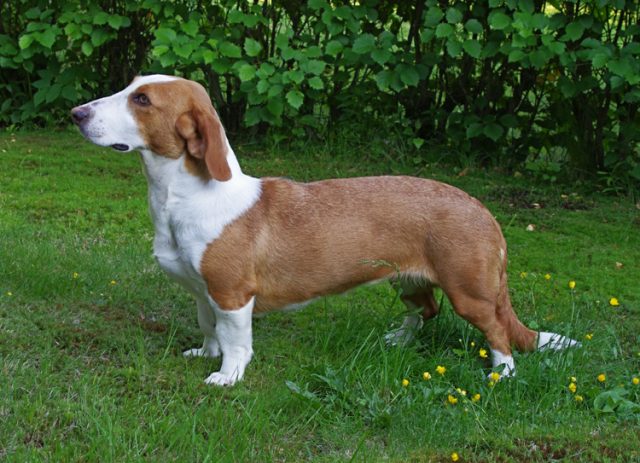Type the name of the breed you're looking for below
[wpdreams_ajaxsearchlite] Don't see the breed your're looking for? Click here and let us know!
Breed Characteristics
1 paw - breed exhibits the least amount of this characteristic
5 paws - breed exhibits most amount of this characteristic
Drever
| Other Names | Swedish Dachsbracke |
| Country of Origin | Sweden |
| Weight | 32 - 34 lbs. (14 - 16 kg) |
| Height (at withers) | 11 - 16 in. (28 - 40 cm) |
| Coat | The coat is thick, close-fitting, and flat all over the body. |
| Colour | Coat colours come in fawn, black or black/tan; always with the white markings on face, feet, neck, chest and tail tip. Canada allows all colours. |
| Litter Size | 2 - 4 puppies |
| Life Span | 12 - 14 years |
| Origin & History | The Drever is a Swedish breed originating with the Westphalian Dachsbracke (a small hound for tracking deer), brought from Germany to Sweden around 1910, and crossbred with other hounds to adjust "to Swedish terrain and game." By the 1940s there were two distinctive sizes of the Dachsbracke, and a newspaper contest was held in 1947 to choose the new name for the slightly larger variety; Drever was chosen, from the Swedish word drev, referring to a type of hunt where the dogs drive the game towards the hunter. The Drever was then recognised by the Swedish Kennel Club as a separate breed in 1947. The breed is recognised internationally by the Fédération Cynologique Internationale, in Group 6 Scenthounds and related breeds, Section 1.3, Small-sized Hounds. The Drever was recognized by the Canadian Kennel Club in 1956 in the Hound Group, and in 1996 by the United Kennel Club in its Scenthound Group. The breed is also recognized by a long list of minor registries, rare breed groups, hunting clubs, and internet registry businesses, and is promoted in North America as a rare breed pet. It is not currently recognized by The Kennel Club (UK), the Australian National Kennel Council or the New Zealand Kennel Club, or the American Kennel Club. |
| Personality | Alert, calm, friendly and even, the Drever is known for the ongoing slight wag of his tail. The Drever often wants to continue working long after its human companion has satisfied his own hunting instinct. It has a first-class nose and is a powerful tracker. Because of its short legs, it is slower than other hounds. This makes it ideal for maneuvering game toward the hunter's gun. The Drever is a steady worker that hunts hare, fox, and occasionally deer; but this dog has the courage to pit himself against even a wild boar. In such cases, he circles and dodges the prey, warning the hunter by barking furiously. The Drever has an excellent nose and a musical voice which is much larger than his size would seem to warrant. The Drever was bred to be tenacious on the hunt and therefore it is very important that the owners of this breed are just as stern when dealing with him in order to show him where his place is among his human pack. Owners who are determined and consistent with the rules, displaying a natural firm but not harsh authority over the dog will bring out the best in this breed. Passive owners will find the dog to become stubborn and headstrong. Drevers that lack in mental and physical exercise and/or leadership will develop quirks in their temperament. Socialize this dog well. |
Care Requirements
| Health | Specific health problems or claims of extraordinary health have not been documented for this breed. |
| Grooming | The smooth-haired coat would do well with a regular rubdown with a damp cloth. This breed is an average shedder. |
| Exercise | These are active dogs with surprising stamina. When not hunting they need a daily pack walk or jog. In addition, they will enjoy a session of play in the park. |
| Other Considerations | Most breeds with similar physical traits are bred for a single purpose, but the Drever has been bred to hunt all sizes of game, both hares and roe deer, and is also used to hunt fox and red deer. The Drever has a lot of stamina, and has become a popular hunting hound for deer hunters in northern Norway, Sweden, and Finland (in Finland drevers are not allowed in deer hunting yet, but it is used for hare and fox hunting). Roe deer are nervous quarry, and the hounds which are used to hunt them must move slowly, especially in areas where heavy snow can be expected in late autumn. This is given as the reason for breeding of a dog with a medium-sized body but short legs. The Drever in Sweden is usually kept as a hunting hound and is not usually found as a pet. |



